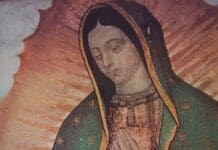Although a large majority have been lost to history, some of the earliest relics of the Church still survive to this day. The relics that do remain are safely stored and kept around the world in churches and cathedrals to be seen and venerated by the Faithful. However, given Mary’s Assumption into Heaven, in which she left behind no physical body on Earth, no bodily relics remain. One relic that does remain is the sancta camisia, the veil she wore while giving birth to Jesus Christ.
“Mary died in the presence of all the Apostles, but that her tomb, when opened upon the request of St. Thomas, was found empty; wherefrom the Apostles concluded that the body was taken up to heaven.” – Saint John Damascene
Tradition says the sancta camisia, Latin for holy shirt, is the veil that was worn by the Virgin Mary during the Birth of Christ. It is over twenty feet long and made of fine silk. After the Assumption of Mary, it is said the veil was moved from Jerusalem to Constantinople, where Byzantine Empress Irene presented it to the Holy Roman Emperor Charlemagne. In 876, his grandson Charles the Bald gifted it to the Chartres Cathedral in France, where it has remained for over 1100 years.
In 1145, the veil was nearly destroyed when the church housing it caught fire. A few clergy members ran through flames into the churches crypt, veil in hand. It is said three days later they emerged completely unharmed through the intercession of Mary. The phenomenon was deemed a miracle, and taken as sign that the in the ashes of the old church a grander one should be built to venerate her. The Chartres Cathedral was built in its place.
Scientific tests of the veil have dated it back to the first century A.D., and of Syrian origin, lending credence to the tradition that the veil was worn by Mary herself. Today, it is kept safely housed in a golden reliquary beside the altar in the Chartres Cathedral. Every year on August 15th, the feast of the Assumption of Mary, the veil is carried throughout Chartres in a procession.
Editorial credit: Valerie2000 / Shutterstock.com


















Amen <3
Blessed is our Holy Mother in Heaven <3
Does anyone know whether it was customary in that time for a young Jewish girl in Mary’s circumstances to own a veil of fine silk that was over twenty feet long? That seems unusual to me — but I admit I know very little about the customs of that time and place.
Of course no poor girl at the time had a 20 foot silk veil and no woman of whatever circumstances would wear such a thing while giving birth.
Guess you know everything, have you ever been to the Holy Land and seen what some of the women wear? these veils are on sold in all stores. some people think they know things and do not forming their ideas on false information!
Consumer customs in 2017 are not even remotely good evidence for practices 2,000 years ago.
Karen, and you know this of a certainty exactly how?
Seems perfectly reasonable to me that the angels would have given Our Lady all sorts of lovely gifts. Why wouldn’t they? She is their (and our) Queen.
Minha Nossa Senhora, Senhora das graças, rigI POR NOS.
In the article, it states that “Mary died.” The Catholic Church has refused to make such a proclamation. If Mary was without sin, she could not have died. As death is the penalty of sin. The theologians claim she “fell asleep” and was taken to Heaven. It is very dangerous to make statements that do not harmonize with the teachings of the Church.
John: Jesus is God, and He died and descended into Hell. Then rose again. ANd he was without sin, as was his Mother. Here’s a puzzler for you, was there ever another human who died, descended into Hell, the RAISED HIMSELF TO HEAVEN? if so, let me know who?!
Marv Schmidt
[…] Billy Ryan posts on uCatholic about the sancta camisia: […]
What of. signs from the Middle Ages. Way newer than theses things from 2000 years ago.
Like communion bread that has the the True Blood.
Blood type: DNA?